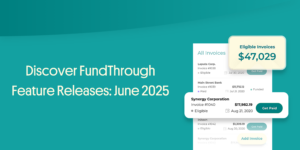
Discover What’s New: FundThrough’s June 2025 Feature Releases
We’re excited to share the latest innovations in the FundThrough platform—updates designed to make your funding experience faster, easier, and more transparent. With improvements to
Home » FundThrough Blog » Four Ways to Rebuild Your Business After COVID-19
With parts of the North American economy reopening, you might be eager to rebuild your business and get back to work. It’s important, however, to exercise caution as the virus continues to spread across both the United States and Canada.
The psychological toll of COVID-19 remains significant. We are facing unemployment levels that we haven’t experienced since the Great Depression. Consumers remain very concerned about public gatherings and proximity to strangers. For many small businesses in retail, restaurants, travel, hospitality and more, we may never see a return to “normal” – or conditions experienced before the outbreak of this virus.
The National Federation of Independent Business (NFIB) reported in March that 92% of small businesses experienced a negative impact from COVID-19. Only 5% of respondents said COVID had no impact, while 3% stated that they have experienced an uptick in business. We will await their latest update on business conditions in April, but signs point to increasing pressure on small business. About 80% of companies that applied for financial assistance through the Paycheck Protection Program (PPP) are still waiting for a check.
Right now, small businesses remain in a holding pattern waiting for this crisis to pass.
[Companies can read our COVID-19 Guide to assess current operations and economic conditions.]
This month represents a period for businesses to assess their current operations and decide how to adjust in the post-COVID world. Today, we’re looking at a series of ways that you can rebuild your company when the world economy rebounds.
Everything comes down to one number for a small business: A profit or a loss. If you’re starting to assess a plan to rebuild your business, you need to update your financial statements and assess the impact on your business. Naturally, you’ll want to examine your sales compared to last year, your cash flow statement, and your profitability.
But now is the time to assess your cash flow.
For example, what are your costs with your suppliers? What subscriptions are you paying for that might be unnecessary? How has this crisis impacted your marketing budget, especially if you’re paying for online marketing and keywords at a time that sales are declining?
In a post-COVID world where physical space – like offices or retail locations – might be less necessary, do you require these costs moving forward? Finally, is now the time to purchase equipment or lease equipment? These types of questions can help boost cash flow and provide you with the working capital you kickstart your recovery plans.
It’s critical to assess every dollar spent to get a better perspective on how you’re using every dollar that comes in the door during this challenging time.
Regardless of whether you are profitable or now, your cash flow is vulnerable to any broader economic downturn that we may face in the future. If you already have debt, you may not be able to tap into new loans from banks. And if you don’t have debt, remember that banks were already strict on lending practices to small business before this crisis.
Before COVID, banks rejected about 80% of small business loans, according to the Federal Reserve. With lending standards tightening, credit card companies capping limits, and every financial institution examining their risk, access to traditional capital could face new limits.
However, now is a very good time to explore alternative finance companies who have the capacity to help small businesses get the working capital they need quickly. While the Paycheck Protection Program is designed to help companies retain employees, the program has struggled to get companies in need of their loans quickly. In addition, it still makes little sense for companies to take on new loans that they have to pay back in the face of a pandemic.
Companies might wish to explore alternative funding options like:
New forms of funding can unlock new potential in this evolving economy. In fact, one of FundThrough’s clients Urban Farms has thrived. The combination of rising food demand and access to cash from customer invoices in less than 24 hours has given then a competitive advantage that would never exist from traditional credit terms. Read more on them, here.
Should consumer behavior remain heavily guarded due to COVID – we could be facing the most radical economic shift in the history of the world. In the blink of an eye, we’ve seen unprecedented damage to the airline industry, hotels, food service, oil-and-gas production, retail shops, restaurants, entertainment venues and the companies that supply products and services to these industries.
Meanwhile, industries like grocery delivery, on-demand entertainment, online education, logistics, technology, software, videoconferencing, and home exercise have thrived (among other examples).
You might feel that your company may be 1,000 miles away from some of these sectors. However, now is the time to determine how you can integrate technology to meet the shifting demands of your customers. Virtually every industry is experiencing these dramatic shifts, which has pushed thought leaders and futurists into overdrive to provide insight in the road forward. We remain very confident that smart entrepreneurs will innovate and pivot to deliver new products and services in this new economy.
Your existing business plan will require a series of changes to accommodate the broad shift in consumer behavior. Consider online mentoring to small business at a company like Score.
On Tuesday, SCORE will host a webinar on how to navigate long-term uncertainty and the aftermath of COVID’s disruption. Consider attending and explore additional events like it.
It remains unclear when this storm may pass. But that doesn’t mean you shouldn’t set a timeline for your business to return to normal. Right now, you will want to explore your timeline for a number of business priorities.
These may include securing business funding or getting invoices paid, rehiring your employees, purchasing supplies and materials, and – of course – flipping that switch from Closed to Open.
Now is the time to set three scenarios: A best-case, a baseline, and a worst-case scenario. Having this plan in place will show creditors, investors, lenders, customers, and suppliers that you are serious about starting to rebuild your business.
While you are focusing on this reboot – consider two other critical sections to your plans. First, have a plan in place in the event that we face another wave of COVID across the country that fuels another round of shutdowns. Preparation is critical, even if we all agree that such a thought is very far from what we hope in the future.
Second – lenders, investors, and suppliers – would find great comfort in knowing that you have contingency plans in the event of another future crisis. Over the last three decades, we have experienced terrorism, a housing crash, and now a pandemic.
Three events – considered statistically improbable – have occurred in our lifetimes, and each has had a dramatic economic impact on small businesses and the world around us.
Build a plan for emergency funds in the future; set plans for employees to work remotely, and continually reassess the intersections between your business and technology and consumer trends for the years ahead. But always be prepared for both opportunities and threats.
Looking ahead, small businesses will require a wealth of resources to help them navigate the challenges on the horizon. FundThrough remains committed to developing thought leadership on small business operations.
In addition, we will continue to share resources with our readers to ensure they have a complete suite of tools to help them thrive in the future.
Please visit the following:
Gartner: Create a Resilient Business Model in the Face of COVID-19
IMA: Small Business Planning During COVID-19
EY: COVID-19 business continuity plan: Five ways to reshape
Small Business Majority: COVID-19 Disaster Relief: Resources and funding options for impacted small businesses
The University of Chicago: COVID-19: SMALL BUSINESS RESOURCES

We’re excited to share the latest innovations in the FundThrough platform—updates designed to make your funding experience faster, easier, and more transparent. With improvements to

The leading fintech funding platform for SMBs secures a $25M Series B equity investment, led by Klister Credit Corp. HOUSTON and TORONTO – April 22,

Key Takeaways: Key Features to Look for in a Small Business Bank: Small business owners should prioritize customer service, security, competitive rates, and comprehensive features
Interested in possibly embedding FundThrough in your platform? Let’s connect!
